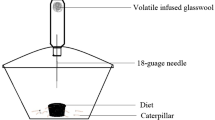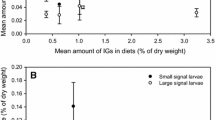Abstract
The behavioral and physiological effects of plant allelochemicals have been difficult to demonstrate; it is not often clear whether the compounds are deterrent, toxic, or both. In this study, we compared the qualitative and quantitative effects of several iridoid glycosides on a generalist lepidopteran herbivore,Spodoptera eridania (Noctuidae). Larval growth and survivorship and larval preference or avoidance were measured on artificial diets containing different iridoid glycosides at different concentrations. We also tested the toxicity/deterrence of these compounds. We found that iridoid glycosides retarded larval growth significantly at relatively low concentrations and that they were usually avoided in preference tests. The toxicity/ deterrence test did not always reflect the results of these other tests. The merits of using a variety of methods for determining deterrence and/or toxicity of plant allelochemicals are discussed.
Similar content being viewed by others
References
Ahmad, S. 1982. Roles of mixed-function oxidases in insect herbivory. Proceedings, 5th International Symposium on Insect-Plant Relationships. Pudoc, Wageningen.
Berenbaum, M. 1978. Toxicity of a furanocoumarin to armyworms: A case of biosynthetic escape from insect herbivores.Science 201:532–534.
Bernays, E.A., andDeluca, C. 1981. Insect anti-feedant properties of an iridoid glycoside: Ipolamiide.Experientia 37:1289–1290.
Blau, P.A., Feeny, P., Contardo, L., andRobson, D.S. 1978. Allylglucosinolate and herbivorous caterpillars: a contrast in toxicity and tolerance.Science 200:1296–1298.
Bobbitt, J.M., Schmid, H., andAfrica, T.B. 1961.Catalpa glycosides. I. The characterization of catalposide.J. Org. Chem. 26:3090–3094.
Bowers, M.D. 1983. The role of iridoid glycosides in hostplant specificity of checkerspot butterflies.J. Chem. Ecol. 9:475–493.
Bowers, M.D. 1984. Iridoid glycosides and hostplant specificity in larvae of the buckeye butterfly,Junonia coenia (Nymphalidae).J. Chem. Ecol. 10:1567–1577.
Bowers, M.D., andPuttick, G.M. 1988. The effect of qualitative variation in iridoid glycosides on generalist and specialist herbivores.J. Chem. Ecol. 14:319–334.
Brausten, L.B., Wilkinson, C.F., andEisner, T. 1977. Herbivore-plant interactions: Mixedfunction oxidases and secondary plant substances.Science 196:1349–1352.
Burnett, W.C., Jones, S.B., Mabry, T.J., andPadolina, W.G. 1974. Sesquiterpene lactonesinsect feeding deterrents inVernonia.Biochem. Syst. Ecol. 2:25–29.
Chambliss, L., andJones, C.M. 1966. Cucurbitacins: Specific insect attractants in Cucurbitaceae.Science 153:1392–1393.
Chang, C.C., andNakanishi, K. 1983. Specionin, an iridoid insect antifeedant fromCatalpa speciosa.J. Chem. Soc. Chem. Commun. 1983:605–606.
Deboer, G., andHanson, F.E. 1984. Foodplant selection and induction of feeding preference among host and non-host plants in larvae of the tobacco hornwormManduca sexta.Entomol. Exp. Appl. 35:177–193.
Feeny, P. 1975. Biochemical coevolution between plants and their insect herbivores, pp. 3–19,in L.E. Gilbert and P.H. Raven (eds.). Coevolution of Animals and Plants. University of Texas Press, Austin, Texas.
Gould, F. 1984. Mixed function oxidases and herbivore polyphagy: the devil's advocate position.Ecol. Entom. 9:29–34.
Inouye, H. 1971. Biosynthesis of iridoid and secoiridoid glucosides, pp. 290–313,in H. Wagner and L. Horhammer (eds.). Pharmocognosy and Phytochemistry. Springer, New York.
Jensen, S.R., Nielsen, B.J., andDahlgren, R. 1975. Iridoid compounds, their occurrence and systematic importance in the angiosperms.Bot. Not. 128:148–180.
Jermy, T., Hanson, F.E., andDethier, V.G. 1968. Induction of specific food preference in lepidopterous larvae.Entomol. Exp. Appl. 11:211–230.
Jirawongse, V. 1964. A chemotaxonomic study of the Scrophulariaceae. PhD thesis. Purdue University, University Microfilms, Inc., Ann Arbor, Michigan.
Kooiman, P. 1972. The occurrence of iridoid glycosides in the Scrophulariaceae.Acta Bot. Neerl. 19:329–340.
Krieger, R.I., Feeny, P., andWilkinson, C.F. 1971. Detoxification enzymes in the guts of caterpillars: An evolutionary answer to plant defenses?Science 172:579–581.
Metcalf, C.L., Flint, W.P., andMetcalf, R.L. 1962. Destructive and Useful Insects, 4th ed. McGraw-Hill, New York.
Miller, J.S., andFeeny, P. 1983. Effects of benzylisoquinoline alkaloids on the larvae of polyphagous Lepidoptera.Oecologia 58:332–339.
Nayar, J.K., andFraenkel, G. 1963. The chemical basis of host selection in the catalpa sphinxCeratomia catalpae (Lepidoptera: Sphingidae).Ann. Entomol. Soc. Am. 56:119–122.
Rhoades, D.F. 1979. Evolution of plant chemical defense against herbivores, pp. 3–54,in G.A. Rosenthal and D.H. Janzen, (eds.). Herbivores: Their Interaction with Secondary Plant Metabolites. Academic Press, New York.
Roby, M.R., andStermitz, F.R. 1984. Penstemonoside and other iridoids fromCastilleja rhexifolia: Conversion of penstemonoside to the pyridine monoterpene alkaloid rhexifoline.J. Nat. Prod. 47:853–859.
Schoonhoven, L.M. 1972. Secondary plant substances and insects.Recent Adv. Phytochem. 5:197–224.
Scriber, J.M., andFeeny, P. 1979. Growth of herbivorous caterpillars in relation to feeding specialization and to the growth form of their food plants.Ecology 60:829–850.
Slansky, F., andFeeny, P.P. 1977. Stabilization of the rate of nitrogen accumulation by larvae of the cabbage butterfly on wild and cultivated food plants.Ecol. Monogr. 47:209–228.
Slansky, F., andScriber, J.M. 1985. Food consumption and utilization, pp. 87–163,in G.A. Kerkut and L.I. Gilbert, (eds.). Comprehensive Insect Physiology, Biochemistry and Pharmacology, Vol. 4. Pergamon Press, Oxford.
Sokal, R.R., andRohlf, F.J. 1969. Biometry. Freeman, San Francisco.
Soo Hoo, C.F., andFraenkel, G. 1966. The selection of food plants in a polyphagous insect,Prodenia eridania (Cramer).J. Insect. Physiol. 12:693–709.
Tietz, H.M. 1972. An Index to the Life Histories of the North American Macrolepidoptera. Allyn Museum of Entomology, Sarasota, Florida.
Usher, B.F., andFeeny, P. 1983. Atypical secondary compounds in the family Cruciferae: tests for toxicity toPieris rapae, an adapted crucifer-feeding insect.Entomol. Exp. Appl. 34:257–262.
Waldbauer, G.P. 1962. The growth and reproduction of maxillectomized tobacco hornworms feeding on normally rejected non-solanaceous plants.Entomol. Exp. Appl. 5:147–158.
Waldbauer, G.P. 1968. The consumption and utilization of food by insects.Adv. Insect. Physiol. 5:229–288.
Author information
Authors and Affiliations
Rights and permissions
About this article
Cite this article
Puttick, G.M., Bowers, M.D. Effect of qualitative and quantitative variation in allelochemicals on a generalist insect: Iridoid glycosides and the southern armyworm. J Chem Ecol 14, 335–351 (1988). https://doi.org/10.1007/BF01022550
Received:
Accepted:
Issue Date:
DOI: https://doi.org/10.1007/BF01022550




